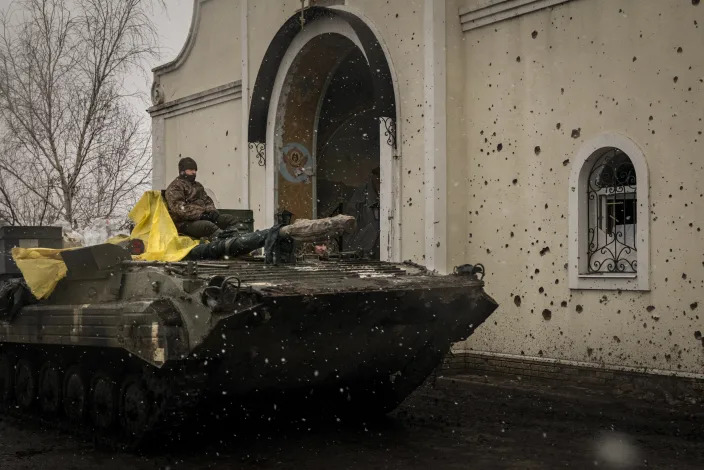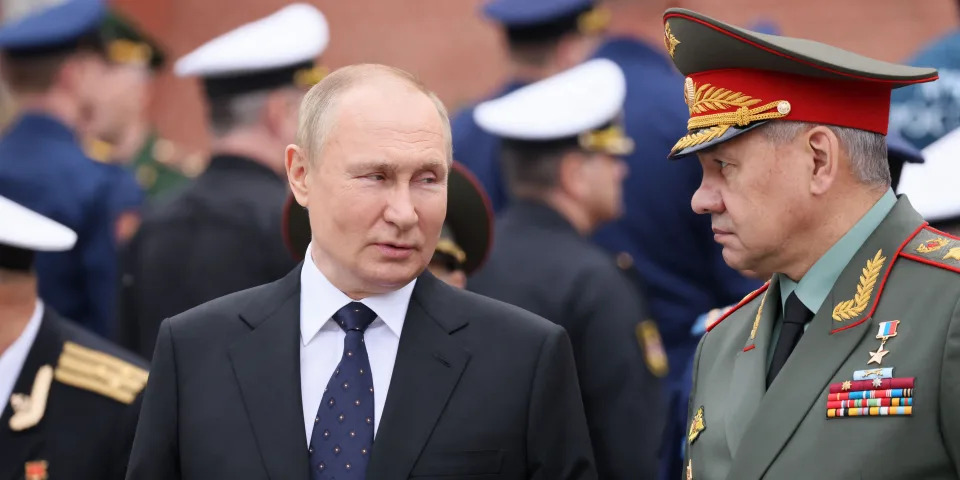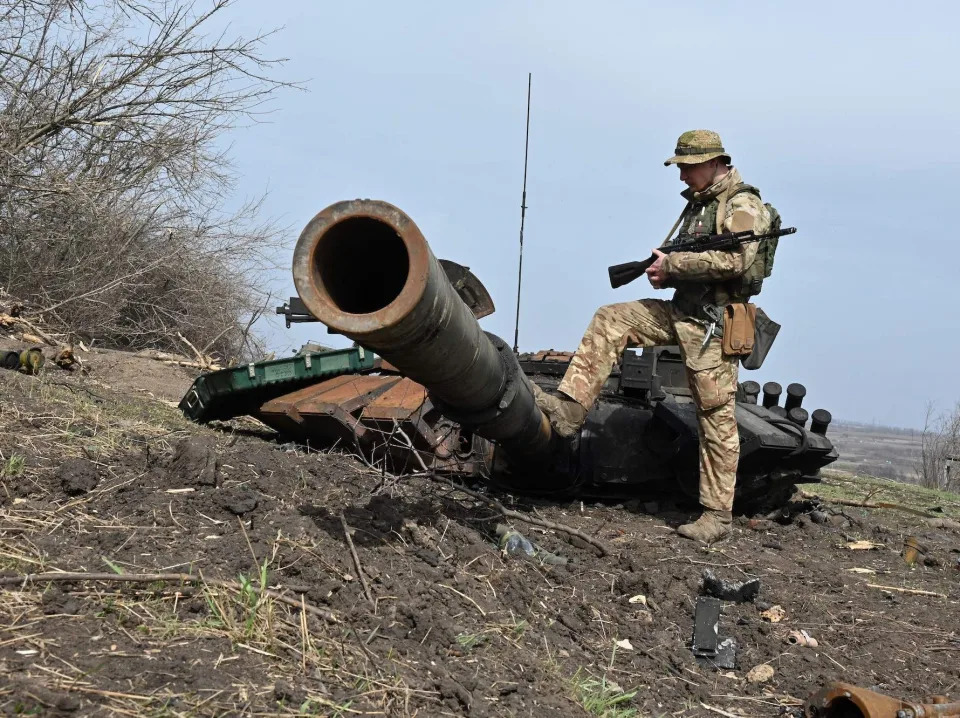
Western Tanks Appear Headed to Ukraine, Breaking Another Taboo 




1k
Lara Jakes and Steven Erlanger
Fri, January 13, 2023 at 5:28 AM PST·8 min read
A Ukrainian armored vehicle passes by a damaged church, in the Donetsk region of Ukraine on Thursday, Jan. 5, 2023. (Nicole Tung/The New York Times)
Western officials increasingly fear that Ukraine has only a narrow window to prepare to repel an anticipated Russian springtime offensive, and are moving fast to give the Ukrainians sophisticated weapons they had earlier refused to send for fear of provoking Moscow.
Over the past few weeks, one barrier after another has fallen, starting with an agreement by the United States in late December to send a Patriot air defense system. That was followed by a German commitment last week to provide a Patriot missile battery, and in the span of hours, France, Germany and the United States each promised to send armored fighting vehicles to Ukraine’s battlefields for the first time.
Now it looks likely that modern Western tanks will be added to the growing list of powerful weapons being sent Ukraine’s way, as the United States and its allies take on more risk to defend Ukraine — especially as its military has made unexpected advances and held out against withering assaults.
Sign up for The Morning newsletter from the New York Times
While Ukraine has been requesting sophisticated tanks since the start of the war, the push to satisfy those pleas gained speed this week as the British and Polish governments publicly urged a change in the Western alliance’s stance. The British signaled that they were close to agreeing to send a small number of tanks, and the Polish government said it would happily send some of its German-made tanks, although Berlin would need to allow it.
Ukraine hopes that the increased pressure will persuade Germany’s Chancellor Olaf Scholz to authorize the export to Ukraine of German-made tanks in the arsenals of other NATO allies. The tanks, called the Leopard 2s, are among the most coveted by Kyiv, and experts say that in significant numbers, they would substantially increase Ukraine’s ability to drive back Russian forces.
“Somebody always has to set an example,” Ukrainian President Volodymyr Zelenskyy told Polish state-run broadcaster TVP Info on Thursday.
A German defense ministry spokesperson said no decision had been made by the government of Scholz, a Social Democrat. But his coalition partners, the Greens and Free Democrats, support sending the tanks, and on Thursday, a senior minister amped up the pressure.
“There is a difference between making a decision for yourself and preventing others from making a decision,” Germany’s economics minister and vice chancellor, Robert Habeck of the Greens, said in Berlin.
Tanks, designed more than a century ago to break through trench warfare, are a combination of firepower, mobility and shock effect. Armed with large cannons, moving on metal treads and built with stronger protective armor than any other weapon on a battlefield, tanks can go over rough, muddy or sandy terrain where wheeled fighting vehicles might struggle.
In Ukraine, officials say armored vehicles will play a key role in battles for control of the fiercely contested towns and cities in the eastern provinces that border Russia. Ukraine’s most senior military commander, Gen. Valery Zaluzhny, has said Ukraine needs some 300 Western tanks and about 600 Western armored fighting vehicles to make a difference.
The sense of urgency over sending more powerful weapons partly reflects the grim standoff on the battlefield in eastern Ukraine, where for months the Russians have tried to seize the city of Bakhmut and the surrounding area, suffering heavy casualties but gaining little ground. In the past week, the fighting has been especially brutal in the nearby town of Soledar, going block to block and house to house, with conflicting claims about control of the town.
NATO allies that were once part of the Soviet sphere have given their Soviet-era tanks to Ukraine. But much of Kyiv’s fleet has been destroyed or worn down by months of battle, and it is running low on ammunition, which is incompatible with Western munitions.
Since the war began nearly a year ago, the West has resisted giving some of its most potent weapons to Ukraine, fearing that would bring NATO into direct conflict with Russia. But seeing Ukraine’s determination to resist, little prospect of peace talks anytime soon, and a stalemate on the battlefield, NATO allies are relenting.
The Patriots they recently agreed to are the most advanced American-made air defense system and will help protect Kyiv and other densely populated areas from Russian strikes that have crippled Ukraine’s electricity grid. The armored fighting vehicles approved last week are lighter and easier to maneuver on the battlefield than tanks and can carry more troops, but are not as powerful.
There are still some weapons not being considered, including fighter jets and longer-range missiles that could hit occupied Crimea and Russia itself. The Biden administration, leading the coalition of allies supplying Ukraine with weapons, is holding back American-made M1 Abrams tanks, which require constant upkeep and special fuel, and which officials say are too scarce to spare.
But U.S. officials maintain they have never stood in the way of Germany or any other nation sending Western tanks to Ukraine. There are an estimated 2,000 German-made Leopard tanks in more than a dozen militaries across Europe. Some could be shipped quickly to Ukraine if Berlin approved, although Ukrainian crews would have to be trained to use them.
A senior Western military official said this week that altering the balance of forces in eastern Ukraine is needed to break the stalemate in the war, and that sending in enough modern Western battle tanks and other combat vehicles could help to tip that balance. Without tanks, a powerful component of ground warfare, it is unlikely that Ukraine will be able to win back significant amounts of territory, the official said.
At the Pentagon, Laura K. Cooper, a deputy assistant secretary of defense, said last week at a briefing that “we absolutely agree that Ukraine does need tanks.”
“This is the right time for Ukraine to take advantage of its capabilities, to change the dynamic on the battlefield,” Cooper said.
Ukraine is set on pushing forward with its own military offensive, either in the depth of winter or after the muddy spring season. Russia, too, is telegraphing a spring offensive, said a senior Western intelligence official, and Ukraine “doesn’t want them to catch their breath” between now and when that intensified round of combat begins.
Camille Grand, a defense expert at the European Council on Foreign Relations, who stepped down as NATO’s assistant secretary-general for defense investment late last year, noted that Moscow appears to be mobilizing hundreds of thousands of new conscripts for its offensive. That, in part, pushed forward the debate about tanks, he said, “to enable the Ukrainian forces to achieve significant progress now.”
Part of the discussion, Grand said, focused on whether the tanks would give Ukrainian forces “some sort of a decisive victory that would force peace on the Russians, or at least to achieve such significant progress that any negotiated settlement would be more on their terms than on Russian terms.”
The issue of whether to allow Leopards to be sent to Ukraine is likely to come to a head at a Jan. 20 meeting of senior defense and military officials from dozens of nations, including NATO states, at Ramstein Air Base in Germany.
Britain has so far said it is considering sending as few as 10 Challenger 2 tanks to Ukraine. Britain has about 227 Challengers, which have maintenance issues, and it would be hard-pressed to replenish its stocks.
Part of the internal debate among British officials is political, a senior European diplomat said. Rishi Sunak, the new prime minister, wants to take some leadership in the war, and Britain and Poland appear to be acting in concert to put pressure on Germany. In a closed-door session of his National Security Council on Tuesday, Sunak outlined a strategy to increase support for Ukraine, likely beginning with the tanks, to give Kyiv an edge before any possible peace negotiations, according to another senior European official.
But Washington’s explicit approval would be vital to pushing Scholz to authorize the Leopards, as it was crucial to the decision to send the German-made fighting vehicles known as Marders, said Claudia Major, a defense analyst with the German Institute for International and Security Affairs in Berlin.
“Pressure on the Leopards is rising from the Poles, the British and the Finns, but it’s about one particular partner, the United States, which is more equal than the others,” she said. “With the Ramstein meeting coming, I expect it to happen soon.”
A senior Biden administration official said Washington had not prodded Berlin to send the tanks to Ukraine, and that the German government would make its own decisions about its level of military support. Speaking on the condition of anonymity to discuss the sensitive issue more candidly, he described the discussions between Washington and Berlin as “very active” and said the Germans, “like us, have evolved their willingness to provide capabilities as the fight has changed over time.” The United States has not told allies to refrain from giving Western tanks to Ukraine, the official said.
The Germans regard such a stance as a cop-out, according to Major, reflecting Washington’s own unwillingness to send any Abrams tanks to Ukraine. She has said that just one Abrams from Washington would be enough to free Scholz to act.
For now, supporters of sending tanks are focused on getting some country to make the first move.
Norbert Röttgen, an opposition German legislator and foreign-policy expert, predicted that Scholz would give in on the Leopards under pressure from allies, as he did earlier with German-made howitzers and tracked armored infantry fighting vehicles.
Scholz and his party “want to keep a relationship with Russia and with Putin for the future,” and Scholz “thinks that if he gives Ukraine the best Germany has, Russia will perceive this as breaking a special relationship,” Röttgen said. “But pressure from allies is becoming too strong.”
© 2023 The New York Times Company



















